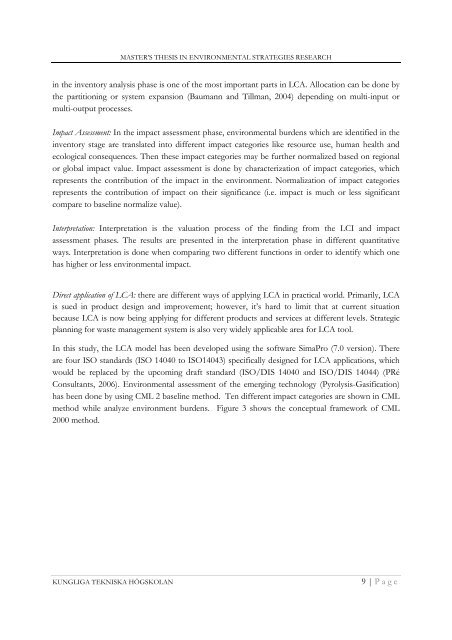Technical Development of Waste Sector in Sweden: Survey
Technical Development of Waste Sector in Sweden: Survey
Technical Development of Waste Sector in Sweden: Survey
You also want an ePaper? Increase the reach of your titles
YUMPU automatically turns print PDFs into web optimized ePapers that Google loves.
MASTER’S THESIS IN ENVIRONMENTAL STRATEGIES RESEARCH<br />
<strong>in</strong> the <strong>in</strong>ventory analysis phase is one <strong>of</strong> the most important parts <strong>in</strong> LCA. Allocation can be done by<br />
the partition<strong>in</strong>g or system expansion (Baumann and Tillman, 2004) depend<strong>in</strong>g on multi-<strong>in</strong>put or<br />
multi-output processes.<br />
Impact Assessment: In the impact assessment phase, environmental burdens which are identified <strong>in</strong> the<br />
<strong>in</strong>ventory stage are translated <strong>in</strong>to different impact categories like resource use, human health and<br />
ecological consequences. Then these impact categories may be further normalized based on regional<br />
or global impact value. Impact assessment is done by characterization <strong>of</strong> impact categories, which<br />
represents the contribution <strong>of</strong> the impact <strong>in</strong> the environment. Normalization <strong>of</strong> impact categories<br />
represents the contribution <strong>of</strong> impact on their significance (i.e. impact is much or less significant<br />
compare to basel<strong>in</strong>e normalize value).<br />
Interpretation: Interpretation is the valuation process <strong>of</strong> the f<strong>in</strong>d<strong>in</strong>g from the LCI and impact<br />
assessment phases. The results are presented <strong>in</strong> the <strong>in</strong>terpretation phase <strong>in</strong> different quantitative<br />
ways. Interpretation is done when compar<strong>in</strong>g two different functions <strong>in</strong> order to identify which one<br />
has higher or less environmental impact.<br />
Direct application <strong>of</strong> LCA: there are different ways <strong>of</strong> apply<strong>in</strong>g LCA <strong>in</strong> practical world. Primarily, LCA<br />
is sued <strong>in</strong> product design and improvement; however, it’s hard to limit that at current situation<br />
because LCA is now be<strong>in</strong>g apply<strong>in</strong>g for different products and services at different levels. Strategic<br />
plann<strong>in</strong>g for waste management system is also very widely applicable area for LCA tool.<br />
In this study, the LCA model has been developed us<strong>in</strong>g the s<strong>of</strong>tware SimaPro (7.0 version). There<br />
are four ISO standards (ISO 14040 to ISO14043) specifically designed for LCA applications, which<br />
would be replaced by the upcom<strong>in</strong>g draft standard (ISO/DIS 14040 and ISO/DIS 14044) (PRé<br />
Consultants, 2006). Environmental assessment <strong>of</strong> the emerg<strong>in</strong>g technology (Pyrolysis-Gasification)<br />
has been done by us<strong>in</strong>g CML 2 basel<strong>in</strong>e method. Ten different impact categories are shown <strong>in</strong> CML<br />
method while analyze environment burdens. Figure 3 shows the conceptual framework <strong>of</strong> CML<br />
2000 method.<br />
KUNGLIGA TEKNISKA HÖGSKOLAN<br />
9 | Page
















